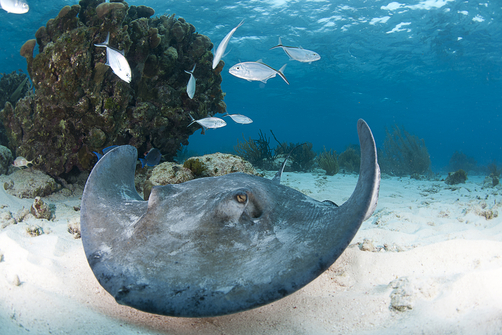Lightning fast reflex stingrays.
- Stingrays are from the family Myliobatiformes, which is the family of fish, known as rays with a cartilage structure, and stingrays have no bones but instead have cartilage and are related to sharks.
- There are more than 60 species of stingray, and they are typically found in warm, coastal waters throughout the world, although they can be seen in some other areas.
- Stingrays can feel the electrical currents a fish produces when it swims, using its electroreceptors and its sense of smell to catch prey.
- Stingrays can camouflage themselves by laying their flat body, coloured similar to the seabed, in the sand and partially burying themselves.
- Stingrays often feed at high tide in reefs with their cousins the sharks, and once they have found their food, they crush their prey of clams, mussels, crabs and shrimps with their super strong teeth.
Stingray
Image courtesy of National Geographic
- Stingrays typically have a litter of between 2 and 13 babies per year that are born as mini versions of an adult.
- Stingrays do not normally attack people unless aggravated by being stepped on or are feeling threatened, although many people are afraid and suspicious of them, particularly since a stingray killed the legendary wildlife protector, Steve Irwin in 2006.
- Stingrays usually have a barbed stinger, that sometimes contains venom, and if stung, it is not normally fatal unless stung near vital organs, but it can be extremely painful and may cause swelling and muscle cramps.
- Stingrays are commonly eaten in Malaysia and Singapore served with a sambal sauce, and they have wing like fins that are served as a delicacy in some countries.
- A stingray swims through the sea by moving side to side or flapping its fins up and down to glide, and they can weigh up to 358 kg (789 pounds) and grow up to 2 meters (6.5 feet) in length although some species grow up to twice that in length.
Bibliography:
Hughes C, Stingrays, 2013, National Geographic Kids, <http://kids.nationalgeographic.com.au/kids/animals/creaturefeature/stingray/>
Stingray, 2013, National Geographic, <http://animals.nationalgeographic.com.au/animals/fish/stingray/>
Stingray, 2013, Wikipedia, <http://en.wikipedia.org/wiki/Stingray>







